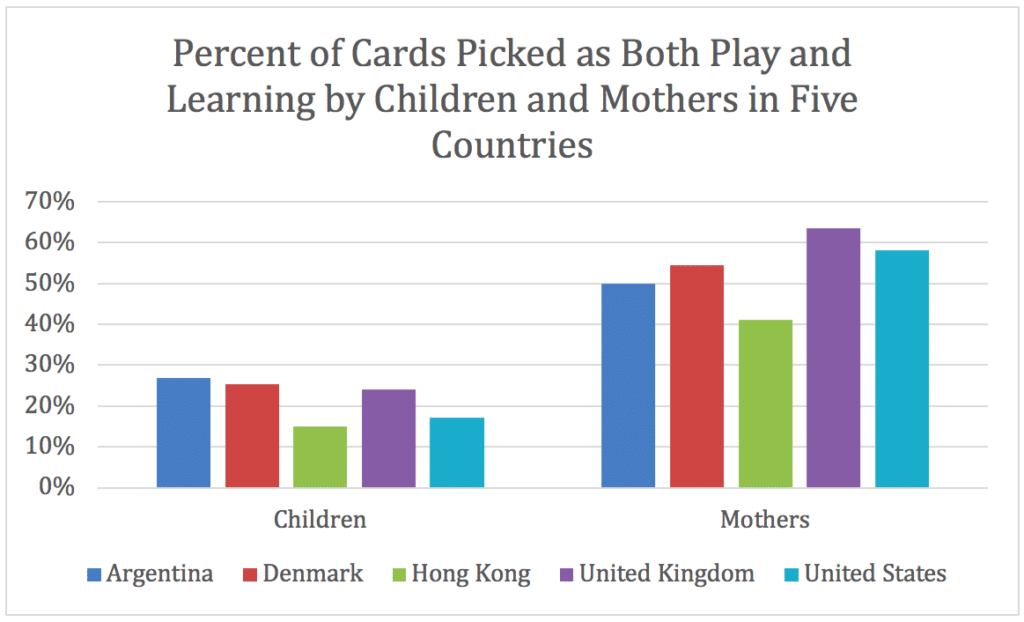I look for stuff to play and teach them all the time, like going on walks, teaching them about being thoughtful stewards of the environment, like I said, cooking, or we garden a lot, and I even have them play with Play-Doh and have them make shapes and all that kind of stuff, lots of playing overlapped with learning (US mother, 2018).
With families living in lockdown, play seems more prominent than ever in children’s lives. Some parents may worry that children are just frittering away their time. To the contrary, caregivers may be reassured that numerous studies suggest that learning is a fundamental part of what occurs during play. As children play, they explore, learn and practice new language skills, and increase their social acumen. For example, during pretend play, children adopt adult characters such as teacher, doctor, or even king and queen, effectively rehearsing the roles of adulthood. Researchers who study play have known for many years that play fuels learning and that the learning gained through play with adults is likely to be even more enriching. Just as the mother quoted above noticed, much learning occurs as children play.
‘Can you play and learn at the same time?’
PALS (Play and Learning Scholars Around the World) asked this question to 200 mothers of young children from five countries (Argentina, Denmark, Hong Kong, the United Kingdom, and the United States) two years before the COVID-19 pandemic.
Our study was designed to uncover how mothers and children think about play and learning. Do mothers recognize—as researchers do—that play promotes learning, or do they think of it as “just” play? Do children consider play and learning to be distinct, given that they spend time in a special place—school—devoted to learning? The only way to answer these questions was to ask mothers and children what they thought.
“Playing and learning aren’t two different subjects … Children learn and play in everything.”
Mothers from all countries recognized that “playing and learning aren’t two different subjects … Children learn and play in everything”, as a mother from Argentina said. Many of them also explained that play is a privileged way of learning. As a mother from Hong Kong told us “I know that children in the course of playing are learning much more than from a book, from play they definitely absorb things easier, with more focus”.
Mothers also highlighted different types of learning that occur during play. For example, a mother from the UK described how children develop problem solving skills by saying, “If you’re playing a game you can still be learning; you can always learn new approaches or new ways to solve problems.” A mother from Argentina described the creativity that comes from playing with clay, noting that her son was “imagining things with that, he’s creating … He’s involved in a world of his own”. In Denmark, one mother focused on both the social and academic skills that children learn through play, saying, “When they play with their friends, they learn the social rules, and when they play in the kitchen … they get to learn about maths and ingredients.”
Clearly, mothers in the countries we studied were well aware that play promotes their children’s learning in many ways and in many domains.
The play and learning embedded in children’s activities
We also separately asked mothers and five- and seven-year-old children to sort 36 cards that depicted a range of activities. Some cards showed activities that represented play (e.g., dressing up as animals and hide-and-seek), some cards depicted school situations (e.g., children sitting at a table writing), while other cards depicted daily activities (e.g., brushing teeth). We asked them to sort the cards into two groups: activities that included play and those that did not. Children and mothers were then invited to sort the cards again, this time separating cards into activities that included learning and those that did not. This allowed us to see which cards mothers and children in these five countries selected to represent both play and learning.

As the figure shows, mothers tend to see learning in pretty much everything that children do; they recognize that learning is a major part of children’s lives and that much of it occurs during play. On the other hand, children make a sharper distinction between play and learning, indicating that activities like hide-and-seek and throwing a ball are exclusively play, while mothers see the learning possible even in playing with bubbles.

In Hong Kong, however, a society known for emphasizing school achievement, children and mothers saw fewer overlaps between play and learning than did their counterparts in other countries. The tension between the traditional emphasis on memorization versus play-based learning is captured by a Hong Kong mother who said, “Once children are in school, then maybe there are things that they need to just memorise; these require rote learning … because it is all for the exams. Playing means that your grades will decline.”
Play and learning in the pandemic
With so many children now doing ‘school at home’, families worldwide may feel pressure to help their children learn in traditional ‘school-based’ ways, given that parents sorted school tasks only into the learning pile. Yet there is nothing wrong with learning in playful ways that keep children’s interest and invite them to have fun at the same time. A mother from the US explained this well: “Yhey learn through play, they learn by experiencing … by conversation … that’s how they develop language skills. I think it’s totally important. Play should be an active part of learning all the time, in school at really any age level.”
Mothers know best! When we listen, many of them tell us what the science says: play and learning often occur simultaneously and together encourage the kinds of skills children need to succeed in the 21st century. And consider: learning doesn’t have to be a slog when it can be joyful and engaging. Which way would you rather learn?
Header photo: Nenad Stojkovic. Creative Commons.
Source: Children - childandfamilyblog.com



